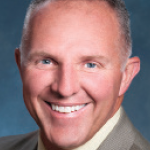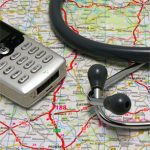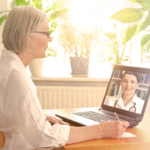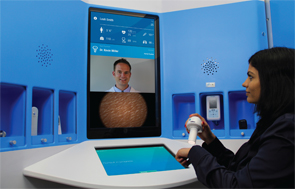
HealthSpot stations are equipped with interactive medical devices and touchscreen computers that connect patients with a medical provider.
Image Credit: HealthSpot
Technology is taking medicine and the Cleveland Clinic and Mayo Clinic to unexpected places. The famed institutions are testing a new way to deliver medical care, with walk-in kiosks mobilized to reach patients who may be too far away, too short on time or facing other challenges that keep them from a traditional doctor’s office visit.
Customers and employees at two pharmacies in Cleveland can walk into a high-tech kiosk to access Cleveland Clinic services through private online, high-definition videoconferences with clinic staff. The kiosks, called HealthSpot stations, are equipped with interactive medical devices and touchscreen computers that connect patients with a medical provider.
Constructed with four walls to enhance privacy, these kiosks are one way the Cleveland Clinic aims to meet patient needs in everyday settings, Cleveland Clinic’s Brian Donley, MD, said in a release. The setup allows for extended hours of operation and flexibility for patients who don’t want to, or can’t, wait until a doctor’s office has an available appointment.
This particular pilot program gives patients the option to walk up to the station without an appointment and receive treatment for minor and common health conditions. Marc’s Pharmacy is the first retailer in Ohio to offer this telehealth platform that, combined with cloud-based software, delivers healthcare in a new-tech way that one day could be expanded to encompass rheumatology and other specialty medicine.
The medical kiosk approach also is being tested in the workplace to enhance employee healthcare options. A handful of health insurance companies currently cover telehealth sessions like a regular office visit.
HealthSpot has placed 20 of its stations in four states so far—California, Florida, Minnesota and Ohio—says Lisa Maugham, HealthSpot’s vice president of marketing. It also partners with other major health systems, including Kaiser Permanente, Miami Children’s Hospital, MetroHealth, Florida Blue and John Carroll University in Ohio.
The Need
The development of walk-in kiosks for patient visits, also dubbed doc pods, reflects the escalating pace of telemedicine in a world where technology has its hands in almost every industry. But can the concept adapt to the field of rheumatology, which is closely reliant on hands-on examination of patients?
Rheumatology patients who live in rural areas that are hours away from the nearest rheumatologist may benefit the most from telemedicine that incorporates technology like that used for the Cleveland Clinic’s kiosks. In his work with tele-rheumatology, Stephen Kropp, MS, system director of eHealth and Outreach Services at Saint Luke’s Health System in Kansas City, Mo., says rheumatology patients often tell him that not having to “drive into the heart of the city” to receive patient care tops the list of patient satisfaction.
In general, the rheumatologists that Mr. Kropp works with have found that for telemedicine to be a meaningful encounter in rheumatology requires specialized nursing support at the patient’s side. The physician’s concern lies in being unable to palpitate joints, consider range of motion and other critical information derived from a physical exam performed in person.
Tick Tock Doc
Dr. Daniel Albert, professor of medicine and pediatrics in rheumatology at Dartmouth College Geisel School of Medicine in Hanover, N.H., has used telemedicine in his practice for about three years. He has not seen the kiosk model in operation, but he notes that there are many possibilities and avenues for telemedicine and they all address fundamentally one thing—access.
“From a standpoint of patient care, getting patients seen in a timely fashion is very hard because you have to book schedules months in advance,” Dr. Albert tells The Rheumatologist. “Then you have very little flexibility for acute care and then when [patients] are booked way out like that, many of them don’t come because the problem has already resolved itself or they sought other care.”
Healthcare Evolves

Dr. Albert
Continuity of care is often a big concern with the use of any type of telemedicine, but one that proponents believe can be overcome. To ensure care continuity, information gathered during HealthSpot visits integrates with electronic records of a Cleveland Clinic patient, say company representatives.
“We built the HealthSpot platform to enable the medical community to extend their services and create new access to care sites that were consumer friendly and low overhead,” notes Steve Cashman, CEO of HealthSpot. “This retail health play by Cleveland Clinic with Marc’s [pharmacy] is a great example of how to evolve healthcare.”
Making Telemedicine Work in Rheumatology

Dr. Lisse
Dr. Jeffrey Lisse, professor of medicine, medical director of the University of Arizona Arthritis Center’s Osteoporosis Program and medical director of the Arizona Telemedicine Program, says the shortage of rheumatologists makes the kiosk model a “promising idea if the challenges can be overcome.
“The training and expertise of the provider with the patient will have a lot to do with how useful the encounter will be,” Dr. Lisse says.
Challenges include the fundamental examination that is performed to assess whether joints are swollen, inflamed or degenerative, which is difficult to do without actually touching the patient, says Dr. Lisse. Currently no devices exist that can be used to aid a physician examining a patient via telemedicine technology, he says.
“This makes it necessary, especially in first encounters, to have another healthcare provider with the patient to evaluate [them],” says Dr. Lisse.
New technology never comes without expense. The operation of a kiosk typically includes a staff attendant—who may need to be trained and certified—as well as the purchase, maintenance and operation of computer and medical device equipment.
It remains to be seen whether this type of medical delivery model could be successful and cost effective and also address liability concerns. Researchers hope to find some answers from pilot programs, such as those being tested by the Cleveland Clinic and the Mayo Clinic.
The Mayo Clinical Health System is offering the kiosks in collaboration with public schools at a location in Minnesota for school employees who can interact electronically with doctors and other medical professionals at the Mayo Clinic. The program, called Mayo Clinic Health Connection, is expected to improve wellness and reduce waiting time for doctor appointments and missed work for employees, Mayo Clinic Health System CEO Dr. Mark Ciota said in a statement.
“Mayo Clinic Health Connection will help school staff and their dependents avoid waiting for traditional healthcare appointments and time away from work, and still get the continuity of care you need from people you trust,” Dr. Ciota said.
Outside of the medical community, big health insurance companies, such as Anthem, Kaiser Permanente and United Health, have begun pilot projects to test the waters with what amounts to walk-in virtual office visits. Programs are being rolled out to large companies that want to take advantage of technological advances by offering their employees greater options when seeking medical help or filling a prescription.
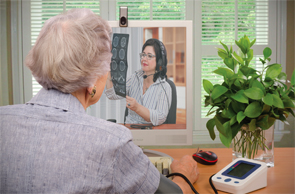
Rheumatology patients who live in rural areas that are hours away from the nearest rheumatologist may benefit the most from telemedicine.
Image Credit: verbaska/shutterstock.com
A company called American Well offers a similar kiosk model typically used for acute care needs, such as a sore throat, skin rashes and sinus infections, according to company spokesperson, Catherine Anderson. They are most often installed in corporation and retail environments.
“Our large health plan clients often deploy the kiosks with their clients to provide easy healthcare access to their employees,” Ms. Anderson explained in an e-mail. “This improves access, provides great convenience and decreases cost of care and absenteeism from work.”
One visit costs about $50 and is often covered by the customer’s health plan, says Ms. Anderson. For now, American Well does not provide specialty medical care through the kiosk setup, but that could change if the technology takes hold.
“We don’t have specific rheumatologists providing care via kiosks, but we do believe that telehealth is moving beyond urgent care and toward providing a variety of specialty and chronic care management,” Ms. Anderson says.
Out of the many specialties in medicine, rheumatology is probably the least suited for telemedicine because of the hands-on aspect of the field, acknowledges Dr. Albert. However, there are ways to work around this inherent obstacle, he says.
“What I tell the telemedicine people is, ‘If we can do it in rheumatology, it can be done in any field,’” says Dr. Albert. “That’s true because we are such a physical exam-based discipline. That’s what’s lacking in telemedicine, but there are ways of doing it that overcome that barrier.”
Perhaps surprisingly, age is not a barrier to making telemedicine work in rheumatology, adds Dr. Albert. Many older patients take to the technology as easily as younger patients and feel comfortable talking with their doctor by video, he says.
If the kiosk model proves successful and efficient enough to move into specialty medical fields, the skill, knowledge and education of the person at the patient’s side, the individual operating the equipment, would be particularly important for rheumatologists, agrees Dr. Albert. For complicated cases, the patient will still have to be seen in the office, but for many patients, he says, some type of telemedicine is the wave of the future.
Catherine Kolonko is a medical writer based in Oregon.
